This was published 7 years ago
Wineglass Bay, Tasmania: Luxury yacht sailing
By Keith Austin
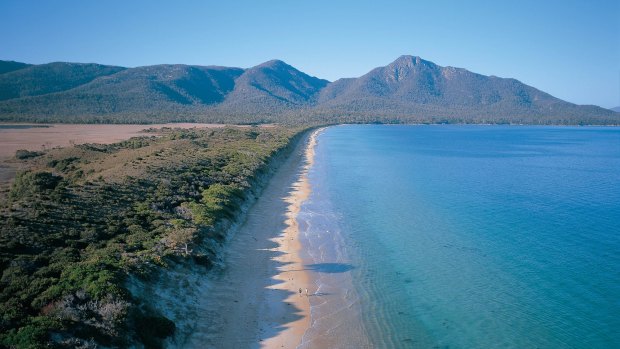
Pristine: Hazards Beach. Credit: Tourism Tasmania
Steve, the captain, is nosing our 22-metre luxury ketch into a craggy cleft in the side of the Ile des Phoques, a lonely granite outcrop off the east coast of Tasmania. The sea is choppy, sloppy and one of our group has already been nicknamed Spewy.
But it's going to be worth it because, according to Steve, there are a couple of sea beagles to be found on the cliffs above. This is news to me and I am agog until someone points out that he said "eagles".
After that, spotting one of said eagles is a bit of a let-down. Imagine that; roiling seas, swollen waves booming against the walls of the cave to starboard, Australian fur seals lumping about on rocks ahead of us and not a beagle in sight. It's a swizz, I tell ya.
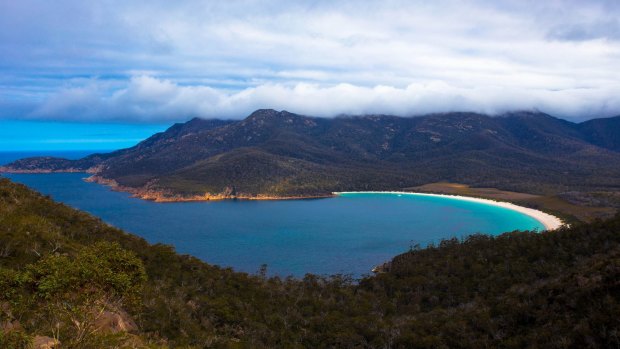
Wineglass Bay from the Wineglass Bay Walking Track.Credit: Tourism Tasmania
But seriously, here's a tip: don't get too close to an Australian fur seal colony unless you have a sea beagle or two to stuff up your nose. Beagles aren't renowned for their sweet aroma but, by God, they hands down beat the stench of a few hundred seals and their puppy-eyed offspring.
The pups are hideously cute but they, like their parents, are wallowing on rocks covered in many hundreds of years of accumulated seal and seabird poo. Imagine what you'd smell like after a few weeks of eating nothing but sushi and gargling with sea water. You certainly wouldn't be welcome in the confines of a ketch, that's for sure.
We have reached the cleverly named Ile des Phoques (Seal Island, don't ask me why) after a short but somewhat chundery trip across the ocean from the small seaside village of Orford, an easy hour's drive from Hobart.
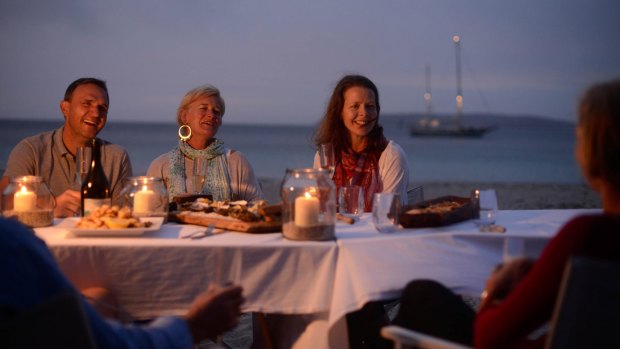
Dining on the beach.Credit: Tasmanian Walking Company
From the beach at Orford, with Maria Island looming offshore, we hop in a tender to reach the Lady Eugenie, which is moored in the bay. We are here with the Tasmanian Walking Company to try out a section of its Wineglass Bay Sail Walk.
This section, from Orford, is usually the beginning of its four-day walk (there's also a six-day version) which takes in Maria Island, Schouten Island, Wineglass Bay and the Freycinet Peninsula. Nights are spent on the yacht while days are given over to hiking and stuffing your face with excellent local food.
We, however, are only on board for one suck-it-and-see night, eschewing Maria Island and a walk up to its 630-metre high peak, and heading straight for Schouten Island via the fetid reek of Ile des Phoques.
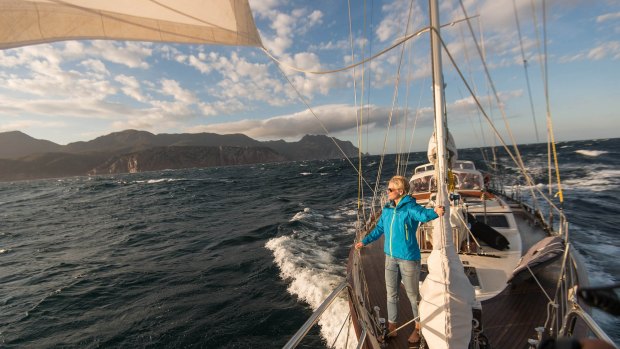
Cruising on the Lady Eugenie.Credit: Tasmanian Walking Company
There are dozens and dozens of seals on the rocks as we approach but they gradually, after a chorus of barked warnings, lollop into the water. It's quite something to watch these lunks flop into the ocean and become sleek, elegant torpedoes.
We photograph the slower-lazier-braver ones, check out the aforementioned cleft around the side then head off towards Schouten Island under sullen clouds and an ocean grown gunmetal gray. It's into this etiolated light that a pod of dolphins arrives, causing much excitement as its component parts cavort under the bow and bowsprit before peeling away and leaping off into the distance.
By the time we get to Schouten Island, about 5pm, the clouds have cleared, the sky is blue and the Lady Eugenie drops anchor. The water is clear enough to see to the bottom where occasional stingrays hover like sunken dinner plates.
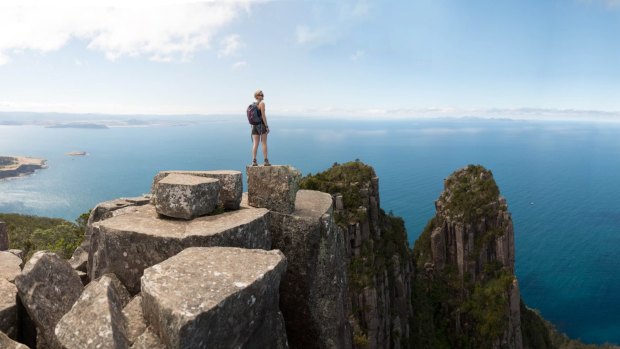
A head for heights definitely helps.Credit: Tasmanian Walking Company
We are late arriving and Dayna Trevaskis, our guide, reckons we won't make it up to the 299-metre-high summit and back before sunset. She is right, but we do make it to the large rock which, seen from the beach, is what gave Bear Rock its name. Though how it's not called Wombat Hill is beyond me.
The hike isn't for the faint of heart. It starts out easily enough, with the path snaking through short undergrowth and banksia trees but it soon becomes much steeper, necessitating some clambering up, over and through tight fissures in the granite boulders that dot the slopes.
It takes just over an hour to reach the bear-shaped rock on the slope just below the summit and as we stop to drink water and take in the panorama of the island and the little toy yacht moored off the beach below, Trevaskis muses that the rocks above us "look like fists".
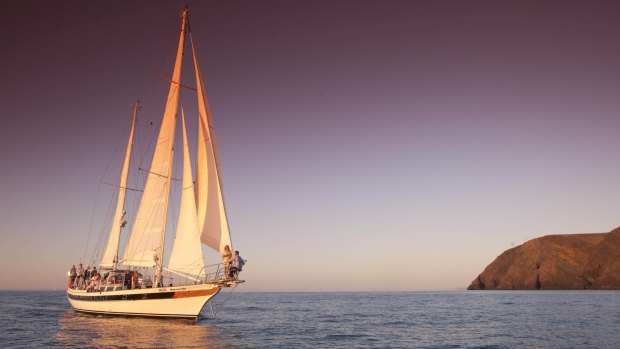
Enjoying the views from the luxury ketch.Credit: Tourism Tasmania
She's right, they do, and it brings to mind a description that has always stuck with me from Titus Groan, book one of Mervyn Peake's acclaimed Gormenghast trilogy: "This tower … arose like a mutilated finger from among the fists of knuckled masonry …"
And it does look like that, as if the ground has been punched through from underneath by the sandstone-coloured fists of a race of underground giants. Apart from the wombat, of course.
The hike feels harder on the way down but it's worth every second when we emerge on the beach to a long, linen-covered table festooned with oysters (from Get Shucked on Bruny Island, no less), Tasmanian cheeses, dips and a couple of bottles of chilled Ninth Island sparkling wine.
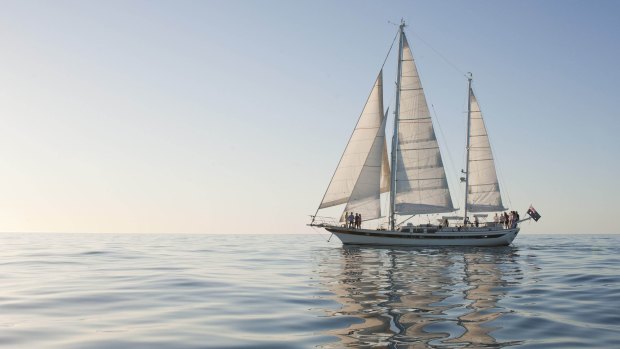
Accommodation is on the Lady Eugenie which has five cabins.Credit: Tourism Tasmania
Behind it, the Lady Eugenie rests at anchor in the twilight, its lights reflecting on the still waters of the bay. It's quite stupidly, wonderfully breathtaking. Take insect spray.
Because we're running a little late, dinner, normally taken on the beach, is cooked up back on the boat by crewman Mitch with help from Trevaskis and consists of Tasmanian salmon, scallops and several freshly made salads.
The boat boasts five cabins – two with double beds and three with bunk beds – and all have aircon, bathrooms and showers. The bunk-bed cabins are what you might call compact and are known, in yachting parlance, as berths. Get on early (it's first come, first served) and claim the bottom bunk if you can because there's not much room up top.
In the morning we breakfast up top – eggs and bacon with fresh fruit, milk and yoghurt also on hand – and are soon standing on the beach again. Only this isn't Schouten Island; we're now at Hazards Beach further north and just across an isthmus from popular Wineglass Bay on the Freycinet Peninsula.
On the regular itinerary this is how day four starts, with a walk along the white, shell-strewn beach before turning on to the Isthmus Track to Wineglass Bay through a fern-heavy landscape.
Trevaskis is an excellent guide, stopping to show us beautiful jewel spiders and parasitic wasps. The spiders are well named, sitting in their webs like tiny pieces of black, white, yellow and orange paper. They also have tiny spines on their abdomens; Jurassic spiders, for sure. The wasps are a different matter and their method of injecting prey with eggs so their offspring can eat it from the inside out is the stuff of nightmares.
At one point I let myself fall behind – the path is well marked so you can't get lost – and linger to enjoy the solitude. There is a faint whiff of eucalypt in the air, the occasional bird call and I'm sure I can hear the faint susurration of waves up ahead.
The bush all around is about waist height and I'm reminded of the velociraptor scenes in the Jurassic Park movies when there is a rustle in the undergrowth beside me and I jump about a foot in the air. I don't know who was more surprised, me or the wallabies that went bounding away.
Wineglass Bay, which we reach after a leisurely 45-minute stroll, is a near-semicircle, its inner arc fringed with brilliant white sand. There are signs asking people to walk on the wet sand rather than disturb the camouflaged nests of shorebirds further up the beach. It's not advice everyone takes.
We confine ourselves to the tidewrack, where a multitude of bluebottles have been left by the receding tide. Trevaskis, again proving her worth, points to snails scattered among them. They are, she says, violet sea snails (Janthina janthina) and they are pelagic bluebottle predators. The little trail of bubbles issuing from them is how they travel the oceans looking for prey.
Trevaskis is also, I should point out, an orchid whisperer. She has an unerring ability to spot them. The name orchid, she explains, comes from orchis, the Greek for testicle. Yup, she's a keeper.
The path up to the Wineglass Bay lookout is, according to the sign at the bottom, just three kilometres away but will take us 1½ hours. It's narrow, steep, rocky and crisscrossed with tree roots but there are plenty of senior American tourists coming down it, and if they can do it …
At the top (and, yes, it does take 90 minutes) we gather with other tourists to take in the view. Wineglass Bay is laid out far below, its beach now a white scalpel slash in the landscape. To the west we can see the isthmus we walked across earlier and, just, a glimpse of Hazards Beach.
Between them the two concave shapes resemble the stem of a wineglass but it's not this which gave the place its name. That is altogether more morbid. For the bay once housed a successful whaling station and the name came from the blood of slaughtered whales as it seeped into the water.
It's a gruesome tale to end a magnificent couple of days so I'll just reveal that there seems to be a tame wallaby that hangs about at the lookout. It is very cute and lets children pat it.
It's not a sea beagle but you can't have everything.
TRIP NOTES
MORE
FLY
Qantas offers direct flights from Sydney and Melbourne to Hobart with connections from other capital cities. See qantas.com
STAY
The Tasmanian Walking Company provides daypacks, rain jackets, basic toiletries (sunscreen, after-sun care, insect repellent) and all meals. Good hiking boots are essential and clear-soled shoes are preferred on the yacht. There are four-day and six-day versions of the Wineglass Bay Sail Walk. Prices start from about $2800 (twin share). See taswalkingco.com.au
Keith Austin travelled as a guest of Qantas and the Tasmanian Walking Company.
Sign up for the Traveller Deals newsletter
Get exclusive travel deals delivered straight to your inbox. Sign up now.